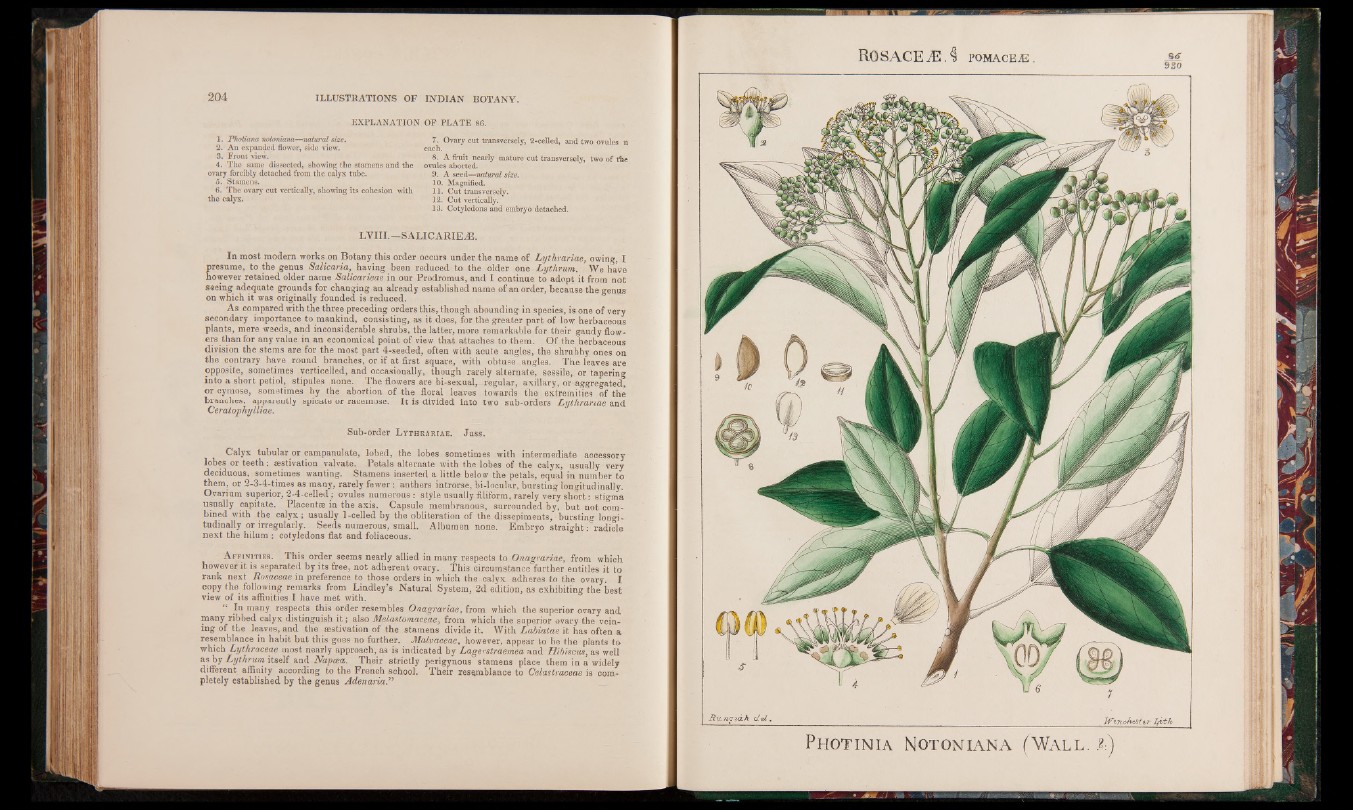
EXPLANATION OF PLATE 86.
1. Photiana notomana—natural size.
2. An expanded flower, side view.
3. Front view.
4. The same dissected, showing the stamens and the
ovary forcibly detached from the calyx tube.
5. Stamens.
6. The ovary cut vertically, showing its cohesion with
the calyx.
7. Ovary cut transversely, 2-celled, and two ovules n
each.
8. A fruit nearly mature cut transversely, two of the
ovules aborted.
9. A seed—natural size.
10. Magnified.
11. Cut transversely.
12. Cut vertically.
13. Cotyledons and embryo detached.
LVIII.—SALICARIEA3.
In most modern works on Botany this order oocurs under the name of L y th ra r ia e , owing, I
presume, to the genus S alicaria, having been reduced to the older one L y th rum . We have
however retained older name Salicarieae in our Prodromus, and I continue to adopt it from not
seeing adequate grounds for changing an already established name of an order, because the genus
on which it was originally founded is reduced.
As compared with the three preceding orders this, though abounding in species, is one of very
secondary importance to mankind, consisting, as it does, for the greater part of low herbaceous
plants, mere weeds, and inconsiderable shrubs, the latter, more remarkable for their gaudy flowers
than for any value in an economical point of view that attaches to them. Of the herbaceous
division the stems are for the most part 4-seeded, often with acute angles, the shrubby ones on
the contrary have round branches, or if at first square, with obtuse angles. The leaves are
opposite, sometimes vorticelled, and occasionally, though rarely alternate, sessile, or tapering
into a short petiol, stipules none. The flowers are bi-sexual, - regular, axillary, or-aggregated,
or cymose, sometimes by the abortion of the floral leaves towards the extremities of thé
branches, apparently spicate or racemose. It is divided into two sub-order3 L y th ra r ia e and
Ceratophylliae.
Sub-order L ythra riae. J uss.
Calyx tubular or campanulate, lobed, the lobes sometimes with intermediate accessory
lobes or teeth: aestivation valvate. Petals alternate with the lobes of the calyx, usually very
deciduous, sometimes wanting. Stamens inserted a little below the petals, equal in number to
them, or 2-3-4-times as many, rarely fewer: anthers introrse.-bi-locular, bursting longitudinally.
Ovarium superior, 2-4-celled; ovules numerous: style usually filiform, rarely very short: stigma
usually capitate. Placentae in the axis. Capsule membranous, surrounded by, but not combined
with the calyx; usually 1-celled by the obliteration of the dissepiments, bursting longitudinally
or irregularly. Seeds numerous, small. Albumen none. Embryo straight: radicle
next the hilum : cotyledons flat and foliaceous.
Affinities. This order seems nearly allied in many respects to Onagrariae , from which
however it is separated by its free, not adherent ovary. This circumstance further entitles it to
rank next Rosaceae in preference to those orders in which the calyx adheres to the ovary. I
copy the following remarks from Lindley’s Natural System, 2d edition, as exhibiting the best
view of its affinities I have met with.
“ In many respects this order resembles Onagrariae , from which the superior ovary and
many ribbed calyx distinguish it; also Melastomaceae, from which the superior ovary the vein-
ing of the leaves, and the aestivation of the stamens divide it. With L a b ia ta e it has often a
resemblance in habit but this goes no further. Malvaceae, however, appear to be the plants to
which Lythraceae most nearly approach, as is indicated by Lagerstraemea and Hibiscus, as well
as by L y th r um itself and Naprra. Their strictly perigynous stamens place them in a widely
different affinity according to the French school. Their resemblance to Celastraceae is completely
established by the genus A d e n a ria .”
Rö SACE M . § POMACE AS .
P h o t in ia No t o n ia n a (Wa l l , i )